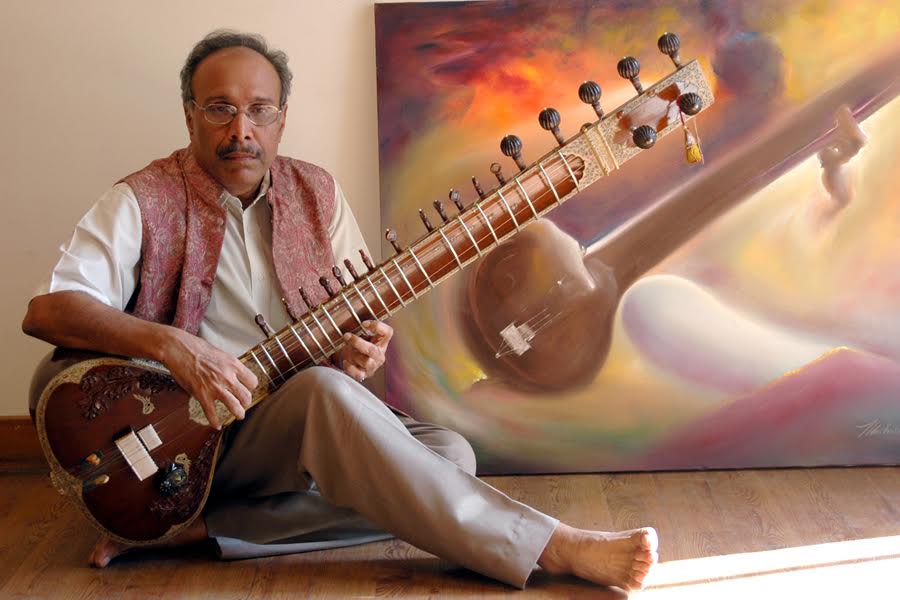Disciple of ‘Aftaab - e - Sitar’ Ustad Vilayat Khan at ‘Kudla Kala Mela’
Disciple of ‘Aftaab - e - Sitar’ Ustad Vilayat Khan at ‘Kudla Kala Mela’
Mangalore Today News Network
Mangaluru, May 29, 2017 : Madhusudan Kumar gave a scintillating Sitar recital at ‘Kudla Kala Mela’, held at Kadri Hill, Mangaluru on 15, April 2017. He was ably accompanied on the Tabla by NageshPai(Disciple of Pt.Taranath who was at ‘Kinnara’ - music school of Sitar maestro Pt. Ravi Shankar).

During his school and college days at St. Aloysius College, he learnt to play Tabla and later Sitar under the tutelage of GulvadyRatnakarBhat(Disciple of Pt. ShridharPalsikar). At Bombay, he continued to learn under Prof .DattatreyaS. Damle(Disciple of Pt. Vishnu DigambarPaluskar) and Radio artiste Pt. Giriraj.
He became the disciple of ‘Bharat Sitar Samrat’ Ustad Vilayat Khan Saheb and resided at Shimla, Dehradun and later at Kolkata; whenever Ustadji arrived from overseas. As an accomplished portrait artist, he painted the oil portraits of the ancestors of the maestro. The ‘Gharana’ was named after Ustad Imdad Khan Saheb, his grandfather and a legendary Surbahar and Sitar performer of his time; termed as a genius. His equally famous father, Ustad Inayat Khan Saheb also contributed immensely to the evolution of the Sitar and music in general, as a multi-facetted personality. His wife Begum Bashiran belonged to the renowned singing ‘gharana’ of Etawah in Uttar Pradesh. Her father,Bande Husain Khan and brother Zinde Husain Khan were the torch bearers of the vocal style of the region.
Vilayat Khan Saheb propounded the ‘Singing Sitar’ by creating the idiom of ‘Gayakiang’ - the ‘Vilayatkhanibaaj’ with a touch of minimalism, by freeing the Sitar from the baritone ‘Beenkaariang’. In order to achieve the five notes ‘meend’(glide), he made several changes in the instrument by discarding the ‘mandra’ss(lower) wires, in tandem with its ace makers like Kanailal brothers, Hiren Roy and his brother Santosh Roy and others. Earlier, Inayat Khan Saheb and Gurudev Rabindranath Tagore too contributed to its evolution (as narrated by Vilayat Khan Saheb).
‘DaaraDaaraDaadaara’- the language of the Sitar with the applications of ‘meend’, ‘zamzama’ (decoration) -balanced and deft usage of the right and left hands are the hallmarks of the‘VilayatKhaniBaaj’.
Hazrat Amir Khosrau(11th CenturyKhilji dynasty at Delhi) adapted many Carnatic ‘Raagas’ to the ‘Hindustani Classical’ tradition. He was the inventor of the three strings Sitar known as ‘Sehtaara’ in Persian. During the six centuries since the Moghul era, Sitar underwent metamorphosis to evolve into the current form and shape.
- A surgeon accused of killing wife with anaesthetic drug in Bengaluru
- Hamas executes 8 Gazans in public amid Trump’s ’Disarm’ warning
- Former Kenya PM, Raila Odinga dies of cardiac arrest in Kerala
- Woman ’raped, robbed’ at knife point on a train in Andhra
- India-origin defence strategist, Ashley Tellis arrested in US
- In Haryana IPS officer’s suicide case, another suicide reveals new twist
- Getting threat calls, abuses for questioning RSS: Priyank Kharge
- Shutdown, politics as Hijab row breaks out in Christian School in Kerala
- Google to invest $15 billion in AI hub in India, Sundar Pichai briefs PM Modi
- Turkey’s Erdogan wants Italian PM Meloni to stop smoking. What she said
- Former IAS officer Kannan Gopinathan joins Congress
- 2 terrorists killed by security forces during infiltration bid in J&K’s Kupwara
- Sudha Murty, family refuse to participate in Karnataka caste survey
- Dharmasthala: SIT questions 11 associates of Mahesh Shetty Thimarody
- Education department to launch campaign to boost enrolment at govt schools
- Mangaluru Junction railway station redevelopment nears completion
- Missing woman’s body found in borewell in Kadur; husband arrested for murder
- Udupi: Three boys drown in sea along Hosahitlu beach
- MP, Kota Srinivas Poojary asks NHAI to begin Katpady flyover works immediately
- Belthangady: Case charged against activist Jayant T. for video on externment order
- Dharmasthala: SIT Likely to record fresh statement from Chinnayya in mass burial case
- Lokayukta raids RTO officer Lakshminarayana P. Naik residence in Udupi
- Moodbidri attempted rape of minors: Four held, booked under POCSO act
- Government defends Mahesh Shetty Thimarodi’s externment as legal and justified
- Massive rally by construction workers demands permanent solution to red stone and sand crisis in DK
- APD Foundation Joins WHO Civil Society Commission
- Daiva’s prediction comes true: Janardhan Reddy walks free from jail
- Skills and Competencies Take Center Stage at MSN Dialogue Series
- Court remands Maoist Lakshmi to six-day police custody
- Sandhya Shenoy honored with Society for Materials Chemistry Medal-2024
- White Cornus Apartment in Mangaluru
- City girl wins first place in state-level spell bee competition
- Alleged ‘Love Jihad’ Case in Mangaluru: Woman left home voluntarily, says police
- Girl fatally struck by reckless two-wheeler near Belman
- New residential complex for the judges inaugurated in Mangaluru
- Absconding accused nabbed after 8 years
- Truck with cylinders turns turtle in Beltangady
- Bhoota Kola artist dies of cardiac arrest
- Development of the country should be our goal: Ganesh Karnik
- Container truck gets stuck under Modankap railway bridge
- CITY INFORMATION
- TRAVEL
- TOURIST INFORMATION
- HEALTH CARE
- MISCELLANEOUS




 Write Comment
Write Comment E-Mail
E-Mail Facebook
Facebook Twitter
Twitter  Print
Print 

